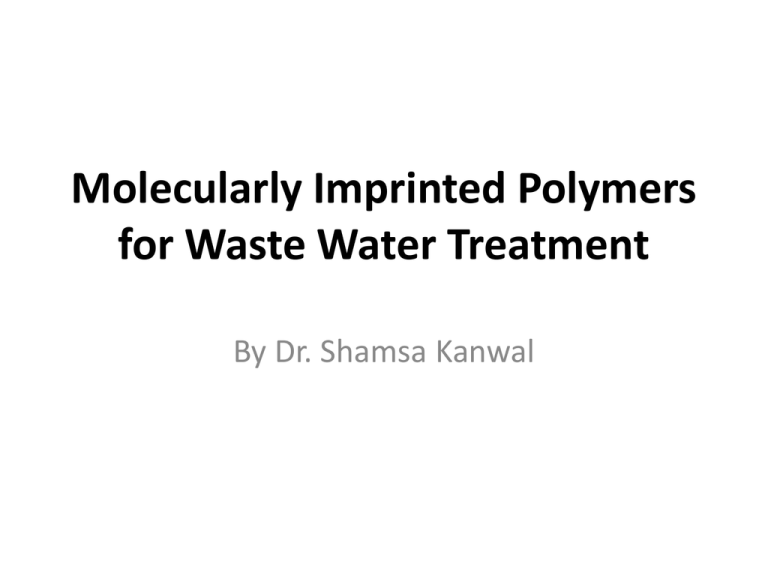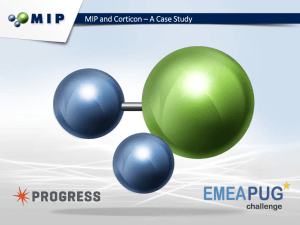Molecularly Imprinted Polymers for Wast Water Treatment
advertisement

Molecularly Imprinted Polymers for Waste Water Treatment By Dr. Shamsa Kanwal • Micropollutants are typically released into the environment via wastewater discharges and land application of biosolids and contaminate the groundwater and surface waters that are used as drinking water resources. • The concentrations of these contaminants are extremely low, typically at levels of parts per billion or parts per trillion, which makes their treatment difficult. However, several laboratory and field studies have shown that even at very low levels, these compounds can accumulate in aquatic organisms and adversely affect growth and reproduction. • Endocrine disrupting compounds (EDCs) are one class of micropollutants, composed of chemicals capable of mimicking or blocking the endogenous hormonal system of animals. Molecularly Imprinted Polymers • MIPs are prepared from cross-linked polymers containing cavities specific to an analyte. These cavities are created by copolymerization of cross-linking monomers and functional monomers along with an imprinting molecule or template. Following polymerization, the template is removed, leaving a cavity specific to the analyte. The MIP then selectively re-binds to the analyte compound. • In a way, MIP technologies imitate biological antibody systems which function on the basis of specific binding sites where an antigen binds strongly to an antibody • MIP are conventionally used as a solid-phase extraction (SPE) media for analytical chemistry. • During most solid phase-extraction procedures, the wide range of contaminants contained in water samples for environmental analysis are coextracted and complex extraction procedures may be required to isolate specific contaminants. MIP technologies offer a simultaneous preconcentration and extraction method because the binding sites on the MIPs are designed to remove a specific contaminant from the water system. Non Imprinted polymers • NIP, on the other hand, are cross-linked polymeric materials that have macropores containing adsorption sites for organic molecules. They are synthesized using the same procedure as MIP, but in the absence of a template. Hence, they have the same chemical properties as MIP but contain no specific cavities. • NIP exhibit strong nonspecific binding which is attributed to hydrophobic interactions between organic compounds and polymers. In MIP studies, NIP particles are studied as a control against MIP particles to compare nonspecific binding to template specific binding. Effect of water characteristics on MIP performance (Effect of pH) Changing the pH of the solution can lead to ionization of the adsorbate or changes in the surface charge of the MIP. Therefore, the effect of pH is specific to the MIP used and must be studied separately for each case. Hajizadeh et al. (2010) reported that bromate adsorption by MIP was optimum at pH 3. They used chitosan MIP and the optimum pH was attributed to the protonation of chitosan to form NH3+ groups, increasing adsorption. Lastly, Luo et al. (2011) studied MIP designed for the removal of acidic dyes. They found that the removal efficiency increased with decreasing pH. They attributed this to bromide ions on the MIP accepting hydrogen ions from the solution giving the MIP a more positive charge which attracted sulfonate ions in the dyes. For water and wastewater treatment applications, the conditions are generally neutral or near-neutral. Therefore, MIP that are most effective under neutral conditions are of special interest. *Hajizadeh S, Kirsebom H, Galaev IY, Mattiasson B (2010) Evaluation of selective composite cryogel for bromate removal from drinking water. J Sep Sci 33:1752–9 *Luo X, Zhan Y, Huang Y, Yang L, Tu X, Luo S (2011) Removal of water-soluble acid dyes from water environment using a novel magnetic molecularl imprinted polymer. J Hazard Mater 187:274–82 Effect of ionic strength Adding ions to the solution can lead either to increased adsorption by decreasing the solubility of the adsorbate in solution or to decreased adsorption by acting like a shield and decreasing the electrostatic attraction between the MIP and the template. Deng et al. (2009) found that adsorption increased with increasing NaCl concentration until nearly all of the adsorbate was removed at a salt concentration of 1 mol/L. The difference between MIP and NIP also decreased at higher salt concentrations. This is probably because decreasing the solubility of the adsorbate would increase the nonspecific binding. Zhang and Hu (2010) found no influence of ionic strength on MIP for adsorption of estrone (E1), or 17 β-estradiol (E2) but increased adsorption of EE2,which was the most hydrophobic compound studied. *Deng S, Shuai D, Yu Q, Huang J, Yu G (2009) Selective sorption of perfluorooctane sulfonate on molecularly imprinted polymer adsorbents. Front Environ Sci Eng China 3:171–7 Effect of Competing Micropollutants • Although MIP are designed with one template molecule, similar molecules are also capable of binding into the specific cavity, and the template experiences some competition from these similar compounds. Both MIP and NIP also exhibit some degree of nonspecific adsorption, which is not compound specific. • Li et al. (2009) studied adsorption with 2,4-D imprinted MIP. They tested adsorption of 2,4-D in the presence of methylbenzene and aniline which have similar structures to 2,4-D. Adsorption decreased from 83.2 % to approximately 72 %, but adsorption of the competitors was below 40 %, indicating good selectivity. *Yu Q, Deng S, Yu G (2008) Selective removal of perfluorooctane sulfonate from aqueous solution using chitosan-based molecularly imprinted polymer adsorbents. Water Res 42:3089–97 * Li Y, Li X, Li Y, Qi J, Bian J, Yuan Y (2009) Selective removal of 2,4- dichlorophenol from contaminated water using noncovalent imprinted microspheres. Environ Pollut (Barking, Essex: 1987)157:1879–85 Effect of water and wastewater constituents • Since MIP have both specific and nonspecific adsorption sites, they should theoretically have some decrease in capacity in the presence of contaminants found in real water or wastewater, but should retain capacity to adsorb the template in the cavity. • Lin et al. (2008) studied the effect of humic acid on the efficiency of MIP for removal of phenolic estrogens. They found no decrease for up to 10 mg/L of humic acid. This was because the monomer (4-vindylpyridine) did not have an interaction with the humic acid. Also, humic acid decreased the pH which increased removal. *Lin Y, Shi Y, Jiang M, Jin Y, Peng Y, Lu B, Dai K (2008) Removal of phenolic estrogen pollutants from different sources of water using molecularly imprinted polymeric microspheres. Environ Pollut (Barking, Essex: 1987) 153:483–91 Application Methods • Because MIP are very small, a means of applying and removing the particles is necessary before they can be used for treatment applications. Two options have been considered for this purpose: the creation and incorporation of the particles into a macroporous gel and the incorporation of a magnetic core into the MIP. • Le Noir et al. (2009) created a PVA cryogel with embedded MIP which was formed inside of plastic carriers. Packed and moving-bed configurations were compared and the moving-bed configuration was shown to be superior due to increased mixing and improved contact between the MIP and solution. • Xia et al. (2012) prepared molecularly imprinted polymer-encapsulated magnetic particles by ultrasonication assisted synthesis in a mixture of water and organic solvent using dual-layered surfactant-modified magnetic particles as core, 17β-estradiol as template, and methacrylic acid as functional monomer. *Le Noir M, Plieva F, Hey T, Guieysse B, Mattiasson B (2007b) Macroporous molecularly imprinted polymer/cryogel composite systems for the removal of endocrine disrupting trace contaminants. J Chrom 1154:158–64 Xia X, Lai EP, Ormeci B (2012) Ultrasonication-assisted synthesis of molecularly imprinted polymer-encapsulated magnetic nanoparticles for rapid and selective removal of 17B-estradiol from aqueous environment. Polymer Engineering and Science, d 10.1002/ pen.23126 Regeneration and reuse of MIP • Regeneration and subsequent reuse of MIP following their use for water and wastewater treatment can reduce the overall costs of treatment. • Several researchers have investigated reuse of MIP including the number of cycles the particles can be reused for and treatment of concentrated micropollutants following regeneration. • Meng et al. (2005) and Li et al. (2009) both regenerated MIP with methanol/acetic acid (9/1, v/v) and were able to reuse the particles for five cycles without a loss in efficiency. Lin et al. (2008) showed that their particles could be used for 30 cycles with no loss in efficiency. However, none of these researchers continued testing the regeneration of the particles until they observed a decrease in performance so it is unknown how many times their particles could have been regenerated. *Meng Z, Chen W, Mulchandani A (2005) Removal of estrogenic pollutants from contaminated water using molecularly imprinted polymers. Environ Sci Technol 39:8958–62 Continued… • Fernández-Álvarez et al. (2009) developed a method for regeneration of MIP with an E2 template using solvent extraction under UV light. This allowed for the regeneration and reuse of both the MIP and the solvent as well as the destruction of E2. Acetone was used as a solvent under UV–vis light. Following a 10h cycle, the MIP were completely regenerated and the acetone contained no residual E2. *Fernández-Alvarez P, Le Noir M, Guieysse B (2009) Removal and destruction of endocrine disrupting contaminants by adsorption with molecularly imprinted polymers followed by simultaneous extraction and phototreatment. J Hazard Mater 163:1107–12 Potential use of NIP for water and wastewater treatment Another idea to consider, which has not been considered in much depth to date, is the use of NIP for water and waste-water treatment (Murray et al. 2011). The main difference between MIP and NIP is their specificity. MIP can selectively target and remove a single compound (such as E2, EE2, etc.) whereas NIP can remove several organic compounds simultaneously. Though MIP generally show higher selectivity and stronger binding to specific chemicals than NIP, NIP may have a higher potential for general water and wastewater treatment applications due to their ability to remove several emerging contaminants simultaneously. *Murray A, Ormeci B, Lai EPC (2011) Removal of 17 beta-estradiol (E2) and its chlorination by-products from water and wastewater using non-imprinted polymer (NIP) particles. Water Sci Technol 64:1291–7 Continued… NIP are also simpler, quicker, and less costly to prepare compared with MIP as they do not require the presence of templates and extensive washing steps for the removal of templates. Most importantly, NIP can be manufactured in large quantities and thus can be used for treatment of large flows. NIP particles appear to be a very promising tool as a polishing step to remove various emerging contaminants and improve the overall quality of treated wastewater. Most researchers investigating the use of MIP for water treatment have inadvertently also tested NIP. NIP are frequently tested alongside MIP to show the strength of the imprinting effect and the difference in binding efficiencies between MIP and NIP is used as a measure of the strength and specificity of the specific adsorption sites on the MIP Physical differences between MIP and NIP • There are some physical differences between MIP and NIP which may account for the differences in adsorption efficiencies. Further investigation of these physical differences may yield information about how to improve the adsorption capacity of NIP. • Investigations into the physical differences are typically used to confirm imprinting of the MIP. MIP are generally more porous and contain visible imprinting cavities. Some researchers have found that this leads to an increased surface area In the cases where the surface area is greater for MIP than NIP, it may be possible to attribute increased binding efficiency of MIP to their larger surface areas. • Randhawa et al. (2007) and Ashraf et al. (2011) created both porous and nonporous MIP and NIP. The porous particles were created by bubbling nitrogen gas into the reaction mixture during polymerization. The porous MIP and NIP both showed better binding of heavy metals confirming the hypothesis that porosity enhances adsorption. *Randhawa M, Gartner I, Becker C, Student J, Chai M, Mueller A (2007) Imprinted polymers for water purification. J Appl Polym Sci 106:3321–6 *Ashraf S, Cluley A, Mercado C, Mueller A (2011) Imprinted polymers for the removal of heavy metal ions from water. Water Sci Technol 64(6):1325–32 Conclusively • The use of MIP and NIP for the removal of emerging contaminants is a novel approach and has the potential to achieve nearly complete removal of micropollutants from water and wastewater. • The technology is based on the adsorption of micropollutants on nanoor submicron-sized polymeric particles and therefore does not result in the generation of oxidation or degradation byproducts that can potentially be more harmful than the parent compound. • MIP and NIP have a particularly high potential for waste-water treatment applications. MIP which are designed to have high selectivity and strong affinity for target chemicals may be ideal for industrial wastewater treatment where high concentrations of specific compounds used in manufacturing need to be removed from wastewater. • NIP, on the other hand, have potential for general water and wastewater treatment applications which typically require the removal of various chemical contaminants simultaneously. Continued…. • It is important to note that potential toxicity and possible health effects of MIP and NIP should be carefully studied before they are considered for drinking water treatment. This information is not currently available in the literature. • The polymeric particles, particularly NIP, are inexpensive to manufacture and can be produced in large quantities. Furthermore, the particles can be regenerated and reused repeatedly. The particles would need to be removed after their application and this can be achieved through physical, chemical, or magnetic separation techniques. More research is required to determine how best to incorporate MIP and NIP in treatment plants. Potential adverse effects of the polymer particles on aquatic ecosystems and human health should also be investigated in future studies. --------------------------------







